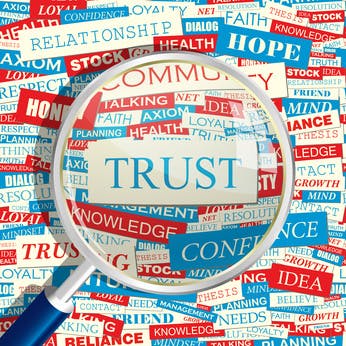Can we reverse the trust decline?
Distrust is the new normal. There has been a dramatic decline over at least the past 15 years in almost every sector of our society —distrust of the police, government, financial institutions, ethnic groups, and even each other.
“Distrust” is the headline every night on the news.
Trust vs. Fear as a performance driver
In the business world, distrust is a daily affair as well, with fear being the driver. The predominant style of leadership, even today, is based on the use of fear to direct workforce behavior, whether it is hierarchy, span of control, accountability or human resource policies.
A culture of fear has a momentum of its own. It gets infused into the very infrastructure of the business, its DNA. Leaders actually come to believe that unless you threaten people’s jobs and security, you won’t get peak performance.
But, quite the contrary is true.
Research has shown that people thrive in their organizations when they feel trusted and engaged, when they own their work and work processes, and know that their leadership believes in them, and will encourage and support them.
If companies want consistently high levels of performance, they need to transform their leadership cultures into ones that are more collaborative — based on the principles of trust and ownership, a culture that believes in the innate competence of the workforce, that they want their companies to win, and want to be proud of who they work for.
Five elements of Trust
To reverse the decline in trust in business, here are five (5) key elements for leaders to consider:
- Trust as a core belief — Trust becomes the core belief system; it means believing in the competence and capability of the workforce; providing the resources and support needed for them to do their jobs; that fear is consciously demolished as a way of doing business.
- Trust as the Culture — Leadership makes a commitment to foster a culture where decisions are made based on principle, not politics; moving from a focus on “I” to a focus on “We”
- Trust through ownership — People take care of what they own; they don’t wash rented cars; the workforce not only owns the values, vision, and mission of the business, but also their work processes and outcomes
- Trust as structure — Trust is built and supported best in teams; it means a team-based, flat, and cross-functional structure; shared responsibility for delivering outcomes
- Trust as learning — People learn through their mistakes; being self-accountable for performance, accountable to one’s peers, all with a focus on learning without fear of retribution
Distrust may be the new normal, but there is hope
Leaders can act on this hope by taking a stand for trust and transforming their cultures to trust-based, collaborative enterprises. Collaborative leaders know that trust-based organizations will out-perform their fear-based counterparts every day of the year.
Does your culture help leaders thrive in collaborative ways? Are these five elements of trust in place? Or can you improve upon even one of these trust elements.
This post originally appeared on CultureUniversity.com.
